实验7:基于REST API的SDN北向应用实践
一、实验目的
1、能够编写程序调用OpenDaylight REST API实现特定网络功能;
2、能够编写程序调用Ryu REST API实现特定网络功能。
二、实验环境
1、下载虚拟机软件Oracle VisualBox或VMware;
2、在虚拟机中安装Ubuntu 20.04 Desktop amd64,并完整安装Mininet、OpenDaylight(Carbon版本)、Postman和Ryu;
三、实验要求
(一)基本要求
1、编写Python程序,调用OpenDaylight的北向接口实现以下功能
(1) 利用Mininet平台搭建下图所示网络拓扑,并连接OpenDaylight;
1、能够编写程序调用OpenDaylight REST API实现特定网络功能;
2、能够编写程序调用Ryu REST API实现特定网络功能。
二、实验环境
1、下载虚拟机软件Oracle VisualBox或VMware;
2、在虚拟机中安装Ubuntu 20.04 Desktop amd64,并完整安装Mininet、OpenDaylight(Carbon版本)、Postman和Ryu;
三、实验要求
(一)基本要求
1、编写Python程序,调用OpenDaylight的北向接口实现以下功能
(1) 利用Mininet平台搭建下图所示网络拓扑,并连接OpenDaylight;
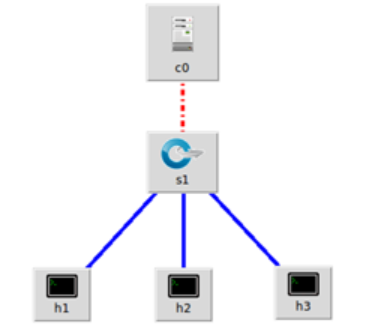
启动ODL
./distribution-karaf-0.4.4-Beryllium-SR4/bin/karaf
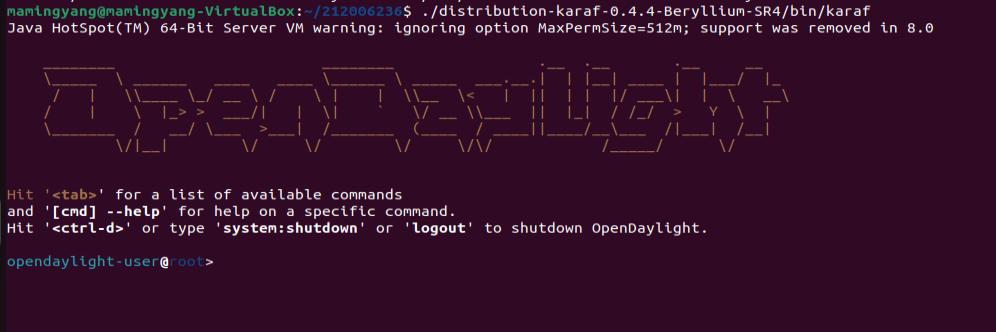
构建topo
sudo mn --topo=single,3 --controller=remote,ip=127.0.0.1,port=6633 --switch ovsk,protocols=OpenFlow13
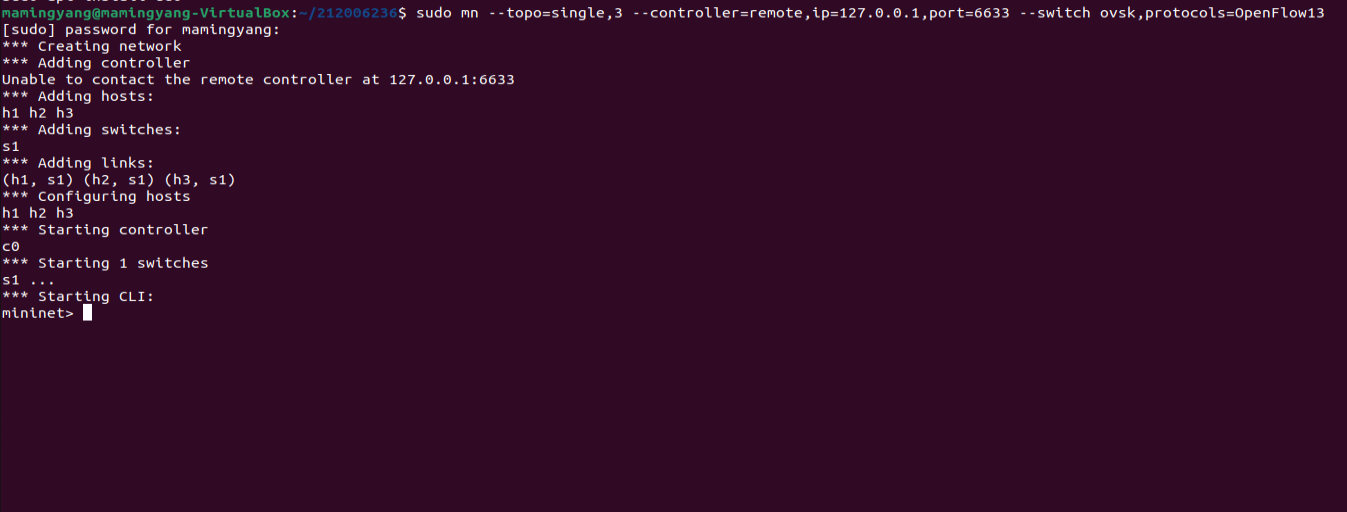

(2) 下发指令删除s1上的流表数据。
- 编写delete.py,调用OpenDaylight的北向接口下发指令删除s1上的流表数据
-
import requests from requests.auth import HTTPBasicAuth if __name__ == '__main__': url = 'http://127.0.0.1:8181/restconf/operational/opendaylight-inventory:nodes/node/openflow:1/' headers = {'Content-Type': 'application/json'} response = requests.delete(url=url, headers=headers, auth=HTTPBasicAuth('admin', 'admin')) print(response.content)

(3)下发硬超时流表,实现拓扑内主机h1和h3网络中断20s。
- 编写timeout.py及timeout.json,调用OpenDaylight的北向接口下发硬超时流表,实现拓扑内主机h1和h3网络中断20s
- timeout.py
#!/usr/bin/python import requests from requests.auth import HTTPBasicAuth if __name__ == "__main__": url = 'http://127.0.0.1:8181/restconf/config/opendaylight-inventory:nodes/node/openflow:1/flow-node-inventory:table/0/flow/1' with open("./timeout.json") as file: str = file.read() headers = {'Content-Type': 'application/json'} res = requests.put(url, str, headers=headers, auth=HTTPBasicAuth('admin', 'admin')) print (res.content)
timeout.json
{ "flow": [ { "id": "1", "match": { "in-port": "1", "ethernet-match": { "ethernet-type": { "type": "0x0800" } }, "ipv4-destination": "10.0.0.3/32" }, "instructions": { "instruction": [ { "order": "0", "apply-actions": { "action": [ { "order": "0", "drop-action": {} } ] } } ] }, "flow-name": "flow", "priority": "65535", "hard-timeout": "20", "cookie": "2", "table_id": "0" } ] }

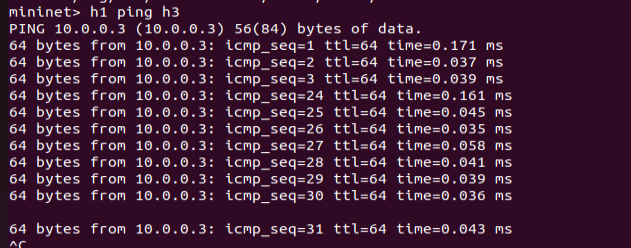
(4) 获取s1上活动的流表数。
- 编写get_flows.py,调用OpenDaylight的北向接口获取s1上活动的流表数
- get_flows.py
import requests from requests.auth import HTTPBasicAuth if __name__ == '__main__': url = 'http://127.0.0.1:8181/restconf/operational/opendaylight-inventory:nodes/node/openflow:1/' \ 'flow-node-inventory:table/0/opendaylight-flow-table-statistics:flow-table-statistics' headers = {'Content-Type': 'application/json'} response = requests.get(url=url, headers=headers, auth=HTTPBasicAuth('admin', 'admin')) print(response.content)
![]()
2、编写Python程序,调用Ryu的北向接口实现以下功能
(1) 实现上述OpenDaylight实验拓扑上相同的硬超时流表下发。
- 编写ryu_timeout.py及ryu_timeout.json,调用Ryu的北向接口实现硬超时流表下发
ryu_timeout.py
-
import requests from requests.auth import HTTPBasicAuth if __name__ == '__main__': url = 'http://127.0.0.1:8080/stats/flowentry/add' headers = {'Content-Type': 'application/json'} json = open('ryu_timeout.json').read() response = requests.post(url, data=json, headers=headers) print(response.content)
ryu_timeout.json
{ "dpid": 1, "cookie": 1, "cookie_mask": 1, "table_id": 0, "hard_timeout": 20, "priority": 65535, "flags": 1, "match":{ "in_port":1 }, "actions":[] }
打开ryu
ryu-manager ryu.app.simple_switch_13 ryu.app.ofctl_rest

创建topo
sudo mn --topo=single,3 --mac --controller=remote,ip=127.0.0.1,port=6633 --switch ovsk,protocols=OpenFlow13

运行ryu_timeout.py

实现硬超时功能

(2) 参考Ryu REST API的文档,基于VLAN实验的网络拓扑,编程实现相同的VLAN配置。
提示:拓扑生成后需连接Ryu,且Ryu应能够提供REST API服务
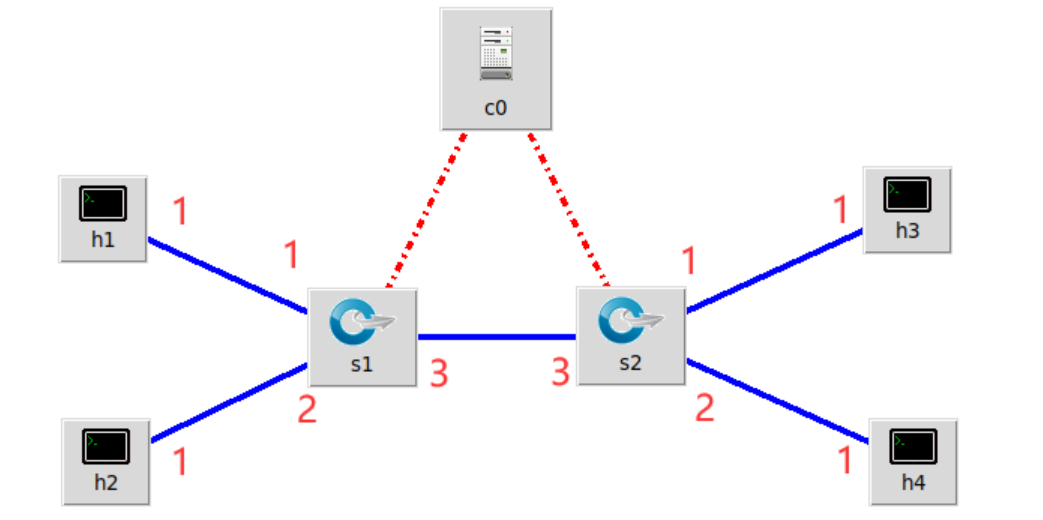
| VLAN_ID | HOST |
|---|---|
| 0 | h1、h3 |
| 1 | h2、h4 |
- 根据VLAN实验的网络拓扑编写ryu_topo.py
ryu_topo.py
from mininet.topo import Topo class ryu_topo(Topo): def __init__(self): Topo.__init__(self) self.addSwitch("s1") self.addSwitch("s2") self.addHost("h1") self.addHost("h2") self.addHost("h3") self.addHost("h4") self.addLink("s1", "h1") self.addLink("s1", "h2") self.addLink("s2", "h3") self.addLink("s2", "h4") self.addLink("s1", "s2") topos = {'ryu_topo': (lambda: ryu_topo())}
ryu_vlan.py
import json import requests if __name__ == '__main__': url = 'http://127.0.0.1:8080/stats/flowentry/add' headers = {'Content-Type': 'application/json'} f = open('ryu_vlan.json').read() flows = json.loads(f)['flows'] [requests.post(url, data=json.dumps(flows[i]), headers=headers) for i in range(0, 8)]
ryu_vlan.json
{ "flows": [ { "dpid": 1, "priority": 1, "match": { "in_port": 1 }, "actions": [{ "type": "PUSH_VLAN", "ethertype": 33024 }, { "type": "SET_FIELD", "field": "vlan_vid", "value": 4096 }, { "type": "OUTPUT", "port": 3 } ] }, { "dpid": 1, "priority": 1, "match": { "in_port": 2 }, "actions": [{ "type": "PUSH_VLAN", "ethertype": 33024 }, { "type": "SET_FIELD", "field": "vlan_vid", "value": 4097 }, { "type": "OUTPUT", "port": 3 } ] }, { "dpid": 1, "priority": 1, "match": { "vlan_vid": 0 }, "actions": [{ "type": "POP_VLAN", "ethertype": 33024 }, { "type": "OUTPUT", "port": 1 } ] }, { "dpid": 1, "priority": 1, "match": { "vlan_vid": 1 }, "actions": [{ "type": "POP_VLAN", "ethertype": 33024 }, { "type": "OUTPUT", "port": 2 } ] }, { "dpid": 2, "priority": 1, "match": { "in_port": 1 }, "actions": [{ "type": "PUSH_VLAN", "ethertype": 33024 }, { "type": "SET_FIELD", "field": "vlan_vid", "value": 4096 }, { "type": "OUTPUT", "port": 3 } ] }, { "dpid": 2, "priority": 1, "match": { "in_port": 2 }, "actions": [{ "type": "PUSH_VLAN", "ethertype": 33024 }, { "type": "SET_FIELD", "field": "vlan_vid", "value": 4097 }, { "type": "OUTPUT", "port": 3 } ] }, { "dpid": 2, "priority": 1, "match": { "vlan_vid": 0 }, "actions": [{ "type": "POP_VLAN", "ethertype": 33024 }, { "type": "OUTPUT", "port": 1 } ] }, { "dpid": 2, "priority": 1, "match": { "vlan_vid": 1 }, "actions": [{ "type": "POP_VLAN", "ethertype": 33024 }, { "type": "OUTPUT", "port": 2 } ] } ] }
-
实现
-
打开ryu
ryu-manager ryu.app.simple_switch_13 ryu.app.ofctl_rest
![]()
topo连接控制器
sudo mn --custom ryu_topo.py --topo ryu_topo --mac --controller=remote,ip=127.0.0.1,port=6633 --switch ovsk,protocols=OpenFlow13
![]()
删除流表
curl -X DELETE http://127.0.0.1:8080/stats/flowentry/clear/1 curl -X DELETE http://127.0.0.1:8080/stats/flowentry/clear/2
运行ryu_vlan.py代码,实现相同的VLAN配置

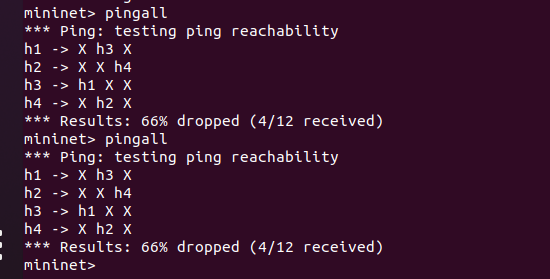
(二)进阶要求
OpenDaylight或Ryu任选其一,编程实现查看前序VLAN实验拓扑中所有节点(含交换机、主机)的名称,以及显示每台交换机的所有流表项。
- 编写getall.py实现查看节点信息
import requests import time import re class GetNodes: def __init__(self, ip): self.ip = ip def get_switch_id(self): url = 'http://' + self.ip + '/stats/switches' re_switch_id = requests.get(url=url).json() switch_id_hex = [] for i in re_switch_id: switch_id_hex.append(hex(i)) return switch_id_hex def getflow(self): url = 'http://' + self.ip + '/stats/flow/%d' switch_list = self.get_switch_id() ret_flow = [] for switch in switch_list: new_url = format(url % int(switch, 16)) re_switch_flow = requests.get(url=new_url).json() ret_flow.append(re_switch_flow) return ret_flow def show(self): flow_list = self.getflow() for flow in flow_list: for dpid in flow.keys(): dp_id = dpid switchnum= '{1}'.format(hex(int(dp_id)), int(dp_id)) print('s'+switchnum,end = " ") switchnum = int(switchnum) for list_table in flow.values(): for table in list_table: string1 = str(table) if re.search("'dl_vlan': '(.*?)'", string1) is not None: num = re.search("'dl_vlan': '(.*?)'", string1).group(1); if num == '0' and switchnum == 1: print('h1',end = " ") if num == '1' and switchnum == 1: print('h2',end = " ") if num == '0' and switchnum == 2: print('h3',end = " ") if num == '1' and switchnum == 2: print('h4',end = " ") print("") flow_list = self.getflow() for flow in flow_list: for dpid in flow.keys(): dp_id = dpid print('switch_name:s{1}'.format(hex(int(dp_id)), int(dp_id))) for list_table in flow.values(): for table in list_table: print(table) s1 = GetNodes("127.0.0.1:8080") s1.show()
![]()
![]()
个人总结:
本次实验考察了对python代码的编程,对于编程能力不好的来说非常困难。
也考察了ODL和ryu的使用。






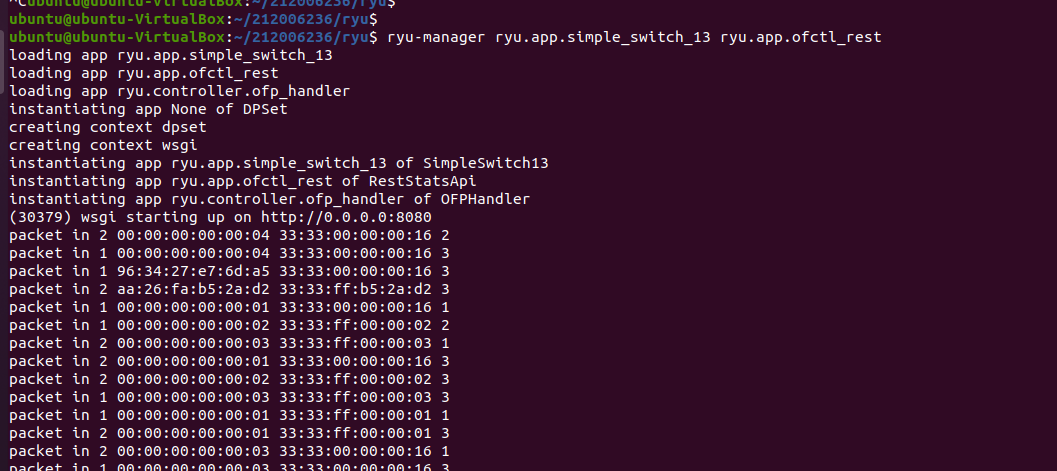





 浙公网安备 33010602011771号
浙公网安备 33010602011771号